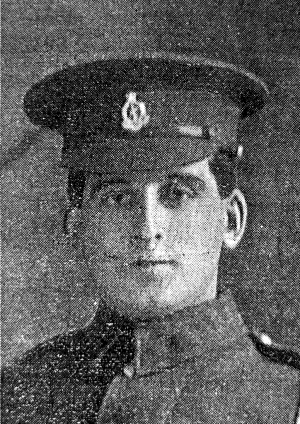
Arthur John Parsons was born in Milborne Port, Somerset in 1893 the elder son of ten children born to Samuel Parsons and his wife Emily (nee Sutton) who married in the Wincanton area in late 1890. Sadly two of the children died before April 1911.
In 1901 and 1911 the family were living at Milborne Port in Somerset. Samuel and all of the children old enough to work, including Arthur, worked in the local leather glove factory. There is no record of the family in Ossett before 1915 and it may be that Arthur made his own way to Ossett since his father, Samuel, died in 1918 in Somerset.
There is no doubt however that Arthur did live in Ossett , albeit for a relatively short period, as indicated by an “Ossett Observer” 1 obituary of the time:
“Another local casualty just reported is that of Private Arthur John Parsons, of the R.A.M.C. From information to hand it appears that he was drowned on August 2nd, while bathing, on the Western Front. The deceased who was 23 years old and a native of Thornhill View, Albert Street, South Ossett, for some time. Prior to enlisting about 12 months ago the deceased worked at the Wood Pit, Netherton, and before that for a short time employed as a conductor on the Ossett and Dewsbury Tramways. He was a member of the Ossett Adult School and during the time he had been in the district he had made many friends.”
Arthur’s army service record has not survived, but it is known that he enlisted in Yeovil, probably in Summer 1916 and he joined the Royal Army Medical Corps with service number 53827. He died on the 2nd August 1916 and was posthumously awarded the British and Victory medals, but not the 1914/15 Star indicating that he did not serve overseas before 31st December 1915.
17th Field Ambulance, Royal Army Medical Corps served with 6th Division, they proceeded to France on the 10th of September 1914, landing at St Nazaire. Then marched at once to the Aisne to reinforce the hard-pressed BEF. They moved north to Flanders and were in action at Hooge in 1915. In 1916 they were again in action at Battle of Flers-Courcelette on The Somme, and again in The Battle of Morval and The Battle of Le Transloy, in 1917 they were in action at Hill 70 and Cambrai. In 1918 they saw action in the Battle of St Quentin, The Battles of the Lys, The Advance in Flanders, Battles of the Hindenburg Line and The Pursuit to the Selle. After the Armistice, 6th Division were selected to join the occupation force and they moved into Germany in mid December, being based at Bruehl by Christmas 1918.
The evidence suggest that Arthur John Parsons arrived in Ossett after April 1911 and returned to Somerset no later than mid 1916. His parents’ address following his death was given as St. Michael’s Road, Penn Mill, Yeovil.
Private Arthur John Parsons is not remembered on any Ossett Memorial or Roll of Honour probably due to his relatively short residence here and because his family appear never to have lived in Ossett. He is remembered in this 2014 biography and Roll of Honour because the “Ossett Observer” were aware of him living in Ossett and reported his obituary accordingly.
Private Arthur J. Parsons, aged 25 years, son of Samuel and Emily Parsons, of 22, St. Michael’s Rd., Penn Mill, Yeovil. Born Milborne Port, Somerset, died on the 2nd August 1916 and is buried at grave reference VII. D. 18A. at the Lijssenthoek Military Cemetery,2 Poperinge, West-Vlaanderen, Belgium. Lijssenthoek Military Cemetery is located 12 km west of Ieper town centre, on the Boescheepseweg, a road leading from the N308 connecting Ieper to Poperinge.
During the First World War, the village of Lijssenthoek was situated on the main communication line between the Allied military bases in the rear and the Ypres battlefields. Close to the Front, but out of the extreme range of most German field artillery, it became a natural place to establish casualty clearing stations. The cemetery was first used by the French 15th Hopital D’Evacuation and in June 1915, it began to be used by casualty clearing stations of the Commonwealth forces.
From April to August 1918, the casualty clearing stations fell back before the German advance and field ambulances (including a French ambulance) took their places.
The cemetery contains 9,901 Commonwealth burials of the First World War, 24 being unidentified. There are 883 war graves of other nationalities, mostly French and German, 11 of these are unidentified. There is one non World War burial here.
The only concentration burials were 24 added to Plot XXXI in 1920 from isolated positions near Poperinghe and 17 added to Plot XXXII from St. Denijs Churchyard in 1981. Eight of the headstones are Special Memorials to men known to be buried in this cemetery, these are located together alongside Plot 32 near the Stone of Remembrance.
CWGC heastone photograph courtesy of Mark Smith
References:
1. “Ossett Observer”, 7th September 1916